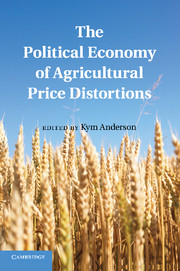Book contents
- Frontmatter
- Contents
- List of Figures
- List of Tables
- Contributors
- Foreword
- Preface
- Abbreviations and Acronyms
- PART ONE Introduction
- PART TWO CONCEPTUAL FRAMEWORKS AND HISTORICAL ORIGINS
- Part Three Political Econometrics: the Past Fifty Years
- NINE Agricultural Price Distortions and Stabilization
- TEN Why Governments Tax or Subsidize Agricultural Trade
- ELEVEN Impacts of Ideology, Inequality, Lobbying, and Public Finance
- TWELVE Agricultural Trade Interventions in Africa
- THIRTEEN Trade Agreements and Trade Barrier Volatility
- FOURTEEN Constitutional Rules and Agricultural Policy Outcomes
- Appendix: Coverage and Distribution of Assistance across Countries and Products, 1955–2007
- Index
- References
TEN - Why Governments Tax or Subsidize Agricultural Trade
Published online by Cambridge University Press: 05 July 2011
- Frontmatter
- Contents
- List of Figures
- List of Tables
- Contributors
- Foreword
- Preface
- Abbreviations and Acronyms
- PART ONE Introduction
- PART TWO CONCEPTUAL FRAMEWORKS AND HISTORICAL ORIGINS
- Part Three Political Econometrics: the Past Fifty Years
- NINE Agricultural Price Distortions and Stabilization
- TEN Why Governments Tax or Subsidize Agricultural Trade
- ELEVEN Impacts of Ideology, Inequality, Lobbying, and Public Finance
- TWELVE Agricultural Trade Interventions in Africa
- THIRTEEN Trade Agreements and Trade Barrier Volatility
- FOURTEEN Constitutional Rules and Agricultural Policy Outcomes
- Appendix: Coverage and Distribution of Assistance across Countries and Products, 1955–2007
- Index
- References
Summary
Why governments choose the instruments they do to restrict or promote trade is not well understood by scholars in economics and political science (Rodrik 1995). That poor understanding helps explain why much of the theoretical and empirical work in international economics has failed to have much of an impact on policy makers, especially when it comes to agricultural trade policies. In practice, episodes of liberalization and reform are often made in the context of crises or under pressure from outside forces (e.g., trade negotiations) rather than from an internal consensus among policy makers about the efficiency gains from agricultural reform. There are significant differences across sectors, countries, and time, but when it comes to agriculture, government interventions across the world have been particularly widespread and persistent, with significant variance in the aim of policies and the types of instruments used.
This chapter is motivated by the question of what motivates governments to tax or subsidize imports and exports. This question, in turn, is important in understanding the constraints that governments perceive they face economically and politically, and in understanding the broader question of the choice of instruments to regulate trade. Better understanding of this question should help in designing multilateral negotiations and agreements that will lead to real reform. A more informed view of the political economy forces that underpin status quo policies is critical in designing and implementing reform strategies.
- Type
- Chapter
- Information
- The Political Economy of Agricultural Price Distortions , pp. 241 - 277Publisher: Cambridge University PressPrint publication year: 2010
References
- 4
- Cited by



